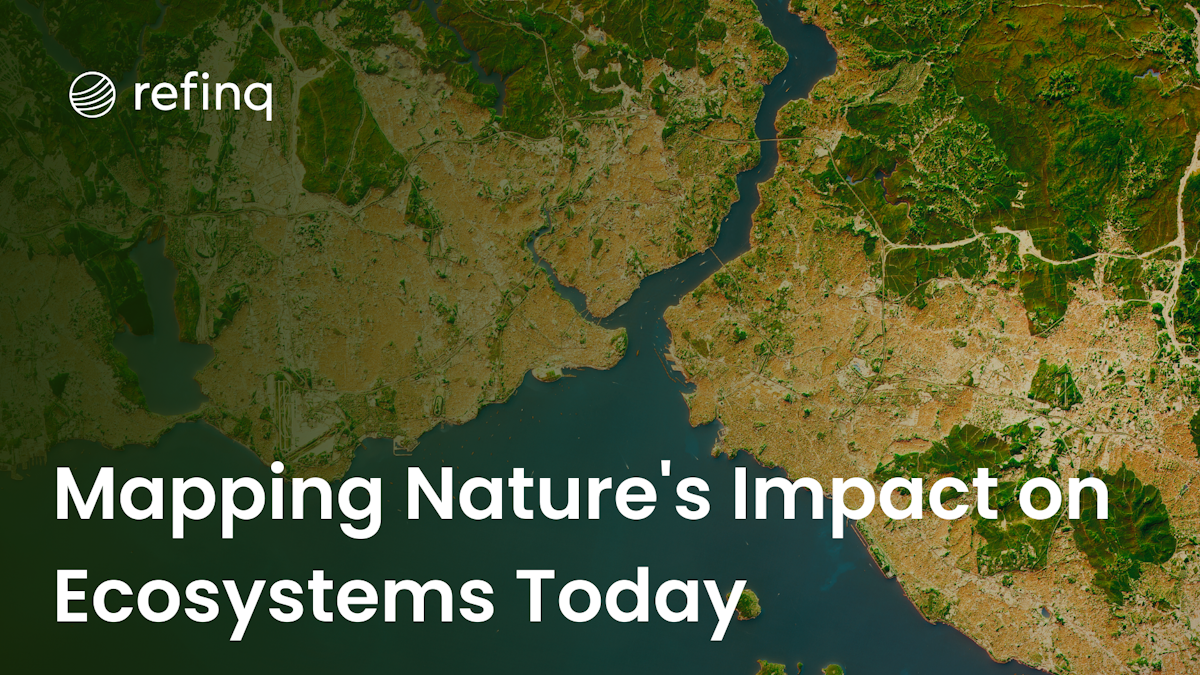Mapping Nature’s Impact on Ecosystems

Understanding how nature influences ecosystems is crucial in our rapidly changing world. Mapping nature's footprint provides insights into the intricate relationships between natural processes and the environments they shape. Recent studies have highlighted the importance of spatial mapping in assessing ecosystem services and biodiversity. (Explore the latest research on ecosystem mapping). Companies like refinq are leveraging advanced technologies to offer comprehensive environmental risk assessments, aiding businesses in navigating nature-related risks. (Discover how refinq empowers businesses).
The integration of geospatial analysis and machine learning has revolutionized the way we map and understand ecosystems. By processing vast amounts of data, scientists can now predict environmental impacts with greater accuracy. (Learn about geospatial mapping of ecosystem services). This advancement is not only beneficial for environmental conservation but also for businesses seeking to develop sustainable strategies.
The Importance of Mapping Nature's Footprint
Understanding Ecosystem Services
Ecosystem Services: The benefits that humans derive from ecosystems, such as clean water, air, and pollination.
Spatial Mapping: Helps in visualizing the distribution of these services and identifying areas of ecological importance.
(Read more on mapping ecosystem services)
Biodiversity and Conservation
Biodiversity Hotspots: Mapping allows for the identification of regions with high biodiversity that require protection.
Conservation Planning: Spatial data supports strategic planning for conservation efforts.
(Explore critical areas for biodiversity)
Technological Advancements in Ecosystem Mapping
Remote Sensing and Satellite Imagery
High-Resolution Data: Satellites provide detailed images of Earth's surface, essential for accurate mapping.
Change Detection: Monitoring environmental changes over time to assess the impact of natural and human activities.
(Learn about remote sensing in environmental mapping)
Machine Learning and AI
Predictive Modeling: Using algorithms to predict environmental changes and potential risks.
Data Integration: Combining various data sources for comprehensive analysis.
(Read about AI in ecosystem impact studies)
What Role Does Geospatial Data Play in Mapping Nature’s Impact?
Definition of Geospatial Data
Geospatial Data: Information that describes objects, events, or phenomena with a location on or near the Earth's surface.
Types of Geospatial Data: Includes satellite imagery, GPS data, and remote sensing outputs.
Applications in Ecosystem Mapping
Spatial Analysis: Geospatial data enables the analysis of environmental patterns and processes.
Habitat Modeling: Assists in predicting species distribution and habitat suitability.
Resource Management: Informs decision-making for sustainable use of natural resources.
(Explore geospatial data's role in ecosystem mapping)
Importance in Environmental Monitoring
Real-Time Data: Provides up-to-date information on environmental changes.
Disaster Response: Aids in assessing the impact of natural disasters on ecosystems.
Policy Development: Supports evidence-based policymaking for conservation efforts.
Where Are Mapping Initiatives Most Needed to Study Nature’s Impact on Ecosystems?
Critical Regions Requiring Mapping
Biodiversity Hotspots: Areas with high species diversity under threat, such as tropical rainforests and coral reefs.
Climate-Vulnerable Zones: Regions highly susceptible to climate change effects, like the Arctic and small island nations.
(Read about critical areas for biodiversity and ecosystem services)
Biodiversity Hotspots
Conservation Priority: Mapping these areas helps prioritize conservation actions.
Species Discovery: Enhances the potential to discover new species and understand biodiversity patterns.
Areas Affected by Climate Change
Glacial Regions: Monitoring melting rates and their impact on sea levels.
Drought-Prone Areas: Assessing land degradation and desertification processes.
(Learn about mapping initiatives in vulnerable ecosystems)
Applications of Ecosystem Mapping
Climate Change Impact Assessment
Vulnerability Analysis: Identifying ecosystems most at risk from climate change.
Adaptation Strategies: Informing policies and actions to mitigate adverse effects.
Sustainable Development
Resource Management: Guiding the sustainable use of natural resources.
Urban Planning: Incorporating green spaces and biodiversity considerations into urban development.
(Discover how mapping aids sustainable development)
How refinq Enhances Ecosystem Mapping and Risk Assessment
refinq is a pioneering SaaS platform designed to help enterprises effectively manage environmental risks through advanced climate and biodiversity risk assessments. With the tagline “Your physical assets are exposed to mother nature. It’s time to act.” (Visit refinq), refinq offers real-time risk evaluations and forecasts of future environmental impacts, processing data for any global location with a granularity of up to 25 meters.
Key Benefits of Using refinq
Extensive Data Integration: Processing over 2.5 billion data points from earth observation and climate models to create comprehensive risk profiles.
Advanced Geospatial Analysis: Utilizes machine learning to translate complex environmental data into actionable insights.
User-Friendly Tools: Features tools for climate and biodiversity risk analysis, tailored for use cases like due diligence and portfolio impact assessment.
Regulatory Compliance: Aligns assessments with international disclosure frameworks like TNFD, CSRD, ESRS, and SBTN, ensuring compliance with regulatory demands.
Future Forecasting: Capable of forecasting environmental impacts based on four climate scenarios extending to the year 2100, empowering businesses to prioritize actions based on significant biodiversity risks.
By incorporating refinq into their environmental strategies, businesses can navigate nature-related risks more effectively, develop sustainable, nature-positive strategies, and ensure regulatory compliance. (Explore refinq's biodiversity solutions)
Conclusion
Mapping nature's impact on ecosystems is essential for understanding the intricate connections between the environment and human activities. Technological advancements like remote sensing, AI, and machine learning have significantly enhanced our ability to assess and predict environmental changes. These tools not only aid in conservation efforts but also provide valuable insights for businesses aiming to implement sustainable practices.
Platforms like refinq play a crucial role in this landscape by offering advanced risk assessments and actionable insights. By leveraging such technologies, organizations can make informed decisions that contribute to environmental preservation while also achieving their strategic objectives.
Relevant Links
Contributions of Ecosystem Mapping to Biodiversity Studies (Nature)
Mapping Critical Areas for Biodiversity and Nature's Contributions (Nature Conservancy)